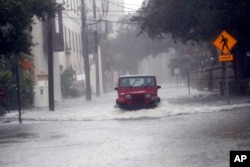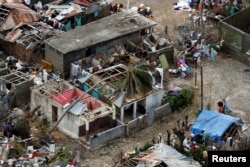Hurricane Matthew has killed nearly 900 people in Haiti and left tens of thousands of people homeless.
The poorest country in the Western Hemisphere has never completely recovered from a devastating earthquake in 2010.
"We lost cows and all our crops," said farmer Geffrard Duplessis about Matthew. "Nothing is left. And our homes are destroyed."
News video shows entire landscapes of metal shanties with their roofs blown off, downed trees and mud from overflowing rivers spilling over onto the ground.
The Haitian town of Jeremie with a population of 30,000 “is completely destroyed,” said Care Haiti director Jean-Michel Vigreux.
The United Nations said nearly 6 million Haitians have been affected by the storm with 350,000 people needing immediate aid.
The International Red Cross has announced an emergency appeal for $6.9 billion in relief aid for Haiti.
Haitian Prime Minister Enex Jean-Charles has announced the creation of a committee comprising Cabinet members to coordinate the distribution of aid provided by donor countries and organizations.
Limited vehicle traffic has been restored to the southern part of Haiti that was cut off when a bridge collapsed Tuesday, enabling more emergency relief workers and supplies to be transported to the isolated region.
Matthew is now moving northward just off the eastern U.S. coast, causing mass evacuations from Florida to North Carolina. The storm has maximum sustained winds of 165 kilometers per hour and rainfall predicted from 20 to 38 centimeters.
Florida Governor Rick Scott has activated 3,500 National Guard troops. Experts say parts of the state could be uninhabitable for weeks.
Matthew unleashed powerful winds and heavy rains on Florida Friday.
Weather forecasters said coastal storm surges combined with high tides and destructive waves pose dangers of “life-threatening inundation” through late Saturday afternoon along coastal areas in Florida, Georgia, South Carolina and North Carolina.
U.S. President Barack Obama has declared states of emergency for all four states.
WATCH: President Obama on his biggest concerns
After meeting Friday with Federal Emergency Management Agency ((FEMA)) administrator Craig Fugate, Obama held a news briefing during which he said, “I just want to emphasize to everybody that this is still a really dangerous hurricane, that the potential for storm surge flooding, loss of life and severe property damage continues to exist.”
One of the areas bearing the brunt of the storm is the northeastern Florida town of Orange Park. Florida resident and former VOA State Department correspondent Pam Dockins said she is temporarily residing there after heeding mandatory evacuation orders in her hometown of St. Augustine.
“The rain is just so, so hard right now. It’s really, really coming down. Sometimes it looks like it’s raining sideways. There is a lot of debris out in the streets. There are a lot of tall trees directly behind where I am and they have been swaying so much in the wind that it’s really a bit of a concern.”
In Brevard County, Florida, where NASA's Cape Canaveral is located, Emergency Management Office spokesman David Walker told VOA mandatory evacuation orders were issued for 90,000 people living on barrier islands and in mobile homes but some people ignored them.
WATCH: Florida Gov. Rick Scott on hurricane concerns
“Some of that can be attributed to hurricane complacency, which is a factor we have to contend with in Florida because we haven’t had a major incident remotely close to this, hurricane-wise, since 2004.”
Walker said one family called for help after the roof of their home “just flew off” and several other residents reported fires of an undetermined cause.
WATCH: US Navy prepares to deliver aid to hurricane victims
The National Hurricane Center called Matthew the strongest hurricane seen in the region in decades.
Some Florida residents who have lived in the state 50 years or more and through the worst that Mother Nature can create fled their homes, telling reporters Matthew looked like a "bad one."
US evacuations
Along the eastern U.S. coast, more than 2 million people were ordered to evacuate their homes and head for safer areas. More than 600,000 people were left without power as Matthew approached the Florida coast, and that number is expected to rise by the hour as the storm makes its way north.
Forecasters predict the storm will track north along the eastern coastlines of Georgia and the Carolinas before heading out to sea, or possibly circling back around to hit Florida again.
VOA's Creole service contributed to this report














